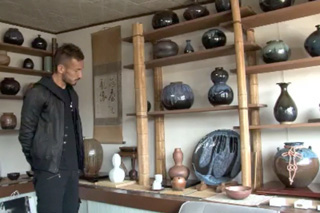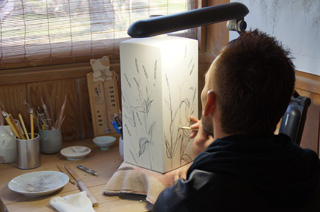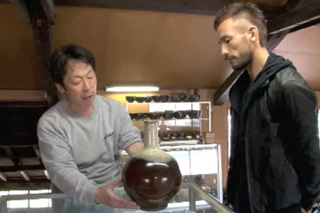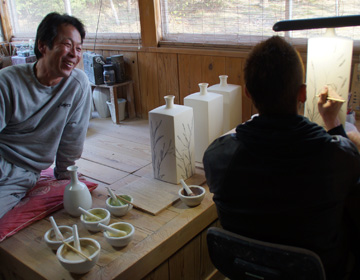 |
The revival of “Narishima Yaki” in YonezawaThere are various types pottery in the regions across the nation, and here in Nagai, they have “Nagai Yaki” and “Narishima Yaki”. There has always been good quality pottery clay in Imaizumi, Nagai, and it was Toshizo Wakui who took notice and started making roof tiles in 1937. Later, first-generation potter Fujio Wakui built a kiln in Nagai and started to make Nagai Yaki with Imaizumi clay, which could retain straight edges without having to use glaze. |
Placing clay to drawOsamu Sakai, whom we interviewed, makes his own porcelain pieces in addition to the two traditional ceramics. What draws our attention is the refined form. The graceful way they stand is utterly indescribable. And the patterns drawn on the pieces enhance their beauty. The seemingly impromptu lines on the white base stand out. They are refined, yet express movement, and the eyes are captivated by the beautiful lines. |
 |
 |
Ceramics last for more than a millennium.Ceramics are the supporting actor, but still can be said to be a centerpiece of culture. “ Wakui commented. Certainly, ceramics have artistic value, but they have also always had value as utensils such as rice bowls, vases, etc. throughout history. “But their value as everyday utensils may be more difficult to convey nowadays. And conveying traditional beauty is even more difficult. But I am not giving up, and always think of ways to develop an understanding of that important point.” Wakui told us. “And since ceramics can last for over a thousand years, I feel responsible to leave things that last through the ages.“ The history of ceramics is long. There are things that do not change and things that need to be changed. Value as a tool is something that will change with the times. Same with beauty. There’s unchanging universal beauty and the beauty valued at some time in history. He continues to challenge works that has both and something that will remain a thousand years into the future. |
ACCESS
- Osamu Nagai, potter
- nagai, Yamagata Prefecture
 Discovering Japan [Nihon] through authentic craftsmanship [Honmono]
Discovering Japan [Nihon] through authentic craftsmanship [Honmono]